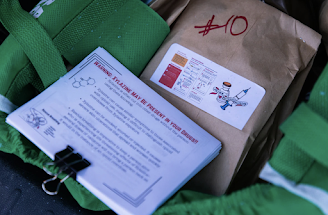 |
| Nicco Quiñones of ABC News films inside the home of Jerry and Veronica Mata. Their daughter Tess, pictured on the wall, was one of 19 students shot and killed in Uvalde, Texas, last May. (Photo by Jenny Wagnon Courts/ABC News via AP) |
By David BauderAssociated Press After most mass shootings that capture the public’s attention, national news organizations will send reporters for a few days, a week maybe, before moving on. There’s always another community, another tragedy.
ABC News tried something different after 19 elementary school students and two teachers were shot and killed in Uvalde, Texas, last May. The journalists stayed.
For a year, ABC kept a team in Uvalde. The result is a nuanced portrait of what happens over time to a suffering community, as seen in the two-hour documentary, “It Happened Here — A Year in Uvalde,” that airs Friday on ABC and Saturday on Hulu.
“What we discovered has been profoundly moving and inspiring and, we hope, useful,” said ABC News President Kim Godwin.
The story’s richness is in the details: There are the children’s rooms left undisturbed since May 24, 2022, the brush a parent can’t give up because it contains a dead girl’s hair, the survivor made upset by the sound of a block of ice being cracked, and the once-carefree boy who worries a lot. And we see a father who sits at his daughter’s grave each night to talk to her.
There are those who lived but deal every day with survivor’s guilt, and there’s the mother who torments herself for not letting her daughter come home with her after a morning awards assembly.
 |
| Uvalde County (Wikipedia map) |
ABC’s idea was born out of a desire to bring something new to stories that have taken on a numbing familiarity. “I don’t think that any community should be defined by a tragedy that befalls it,” said Cindy Galli, executive producer of ABC’s investigative unit.
A core team of about a dozen people were assigned to the project, a significant commitment at a time when ABC News, like many other news organizations, is cutting staff. The team, with reporters John Quiñones, Maria Elena Salinas and Mireya Villarreal, rotated in and out depending on other assignments.
The project enabled the journalists to get to know community members and build trust by talking to them without cameras running all the time, she said.
“One of the aspects of being in a small community is that we would run into people at Starbucks or the grocery store,” Galli said. “They knew that we were there and knew that we were there for the long haul.”
That was important to families dealing with their grief, said Kimberly Rubio, whose daughter Lexi was killed in the attack. Rubio was featured in a segment early in the film, talking about how she uses time spent jogging to reflect upon what happened to her daughter.
“It also helped that it wasn’t different reporters all the time,” Rubio said. “I had two that I worked with. It made it much easier for me to be vulnerable.”
The ABC team filed more than 200 stories during its time in Uvalde, Galli said. Their presence enabled them to break news, such as when Quinones got the first interview with a woman falsely accused of leaving a door open at the school that the killer used for access.
Questions about why it took police more than an hour to enter the affected classrooms kept Uvalde in headlines longer than most mass shootings. ABC’s access deepened the documentary’s narrative retelling of the story, with recordings of a chilling 911 call from a trapped girl pleading for a police response to the gunman.
“I had a pencil,” said Arnie Reyes, a teacher injured that day whose recovery is followed by ABC. “It’s not the same battle.”
The documentary talks about tensions in Uvalde between affected parents and people who supported school administrators and police. That aspect of the story points out a hole in the ABC team’s reporting, although it’s not necessarily their fault: The network had trouble getting people in law enforcement and their supporters to talk.
Lexi’s dad, Felix Rubio, eventually resigned his job as a deputy police officer, explaining that he couldn’t go back to work with people who didn’t rush into the school to try and save the children.
The film also traces the growing activism of Kimberly Rubio and 10-year-old Caitlyne Gonzales in seeking legislation to prevent future school shootings.
 |
| John Quiñones (ABC News photo) |
“There are vital details, nuances that are missed, when we as reporters parachute in and out” of a story, Quinones said.
The extended assignment meshed with how Quiñones likes to report such stories. He doesn’t see the point of reporters trying to force themselves on people when they don’t want to talk. There were times when he had to step away, like when a family he’d been talking to learned that their child might have survived if police had moved more quickly.
The entire experience was eye-opening for the network, Galli said. Following the Uvalde team’s lead, an ABC digital team is spending time in Buffalo, where 10 people were killed in a mass shooting, also in May 2022.
Quiñones, a Mexican American who grew up in nearby San Antonio, said the extended Uvalde assignment has been the most powerful story he’s ever been involved in.
“There’s no doubt in my mind that this is the kind of story that will live with me forever,” he said.





















